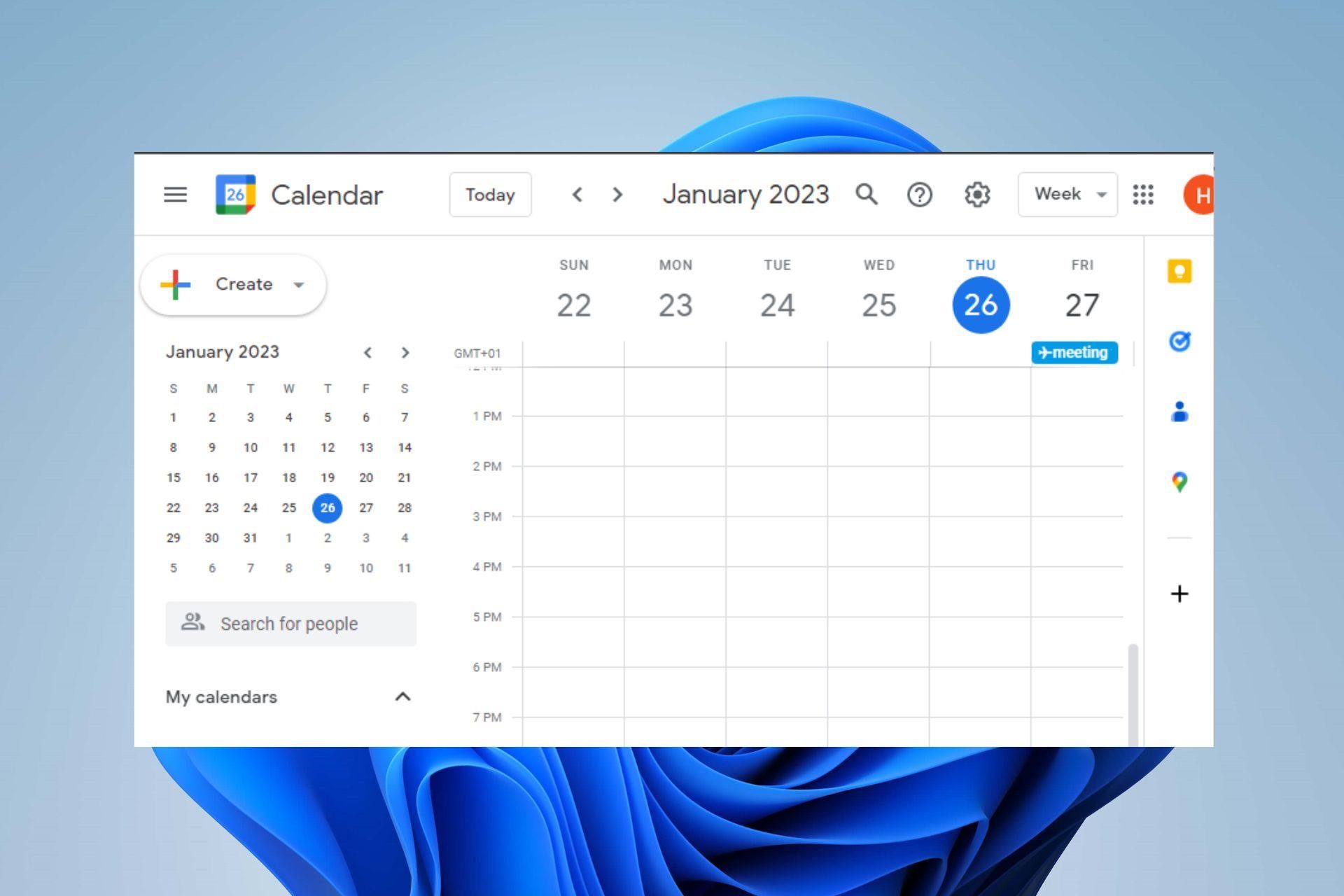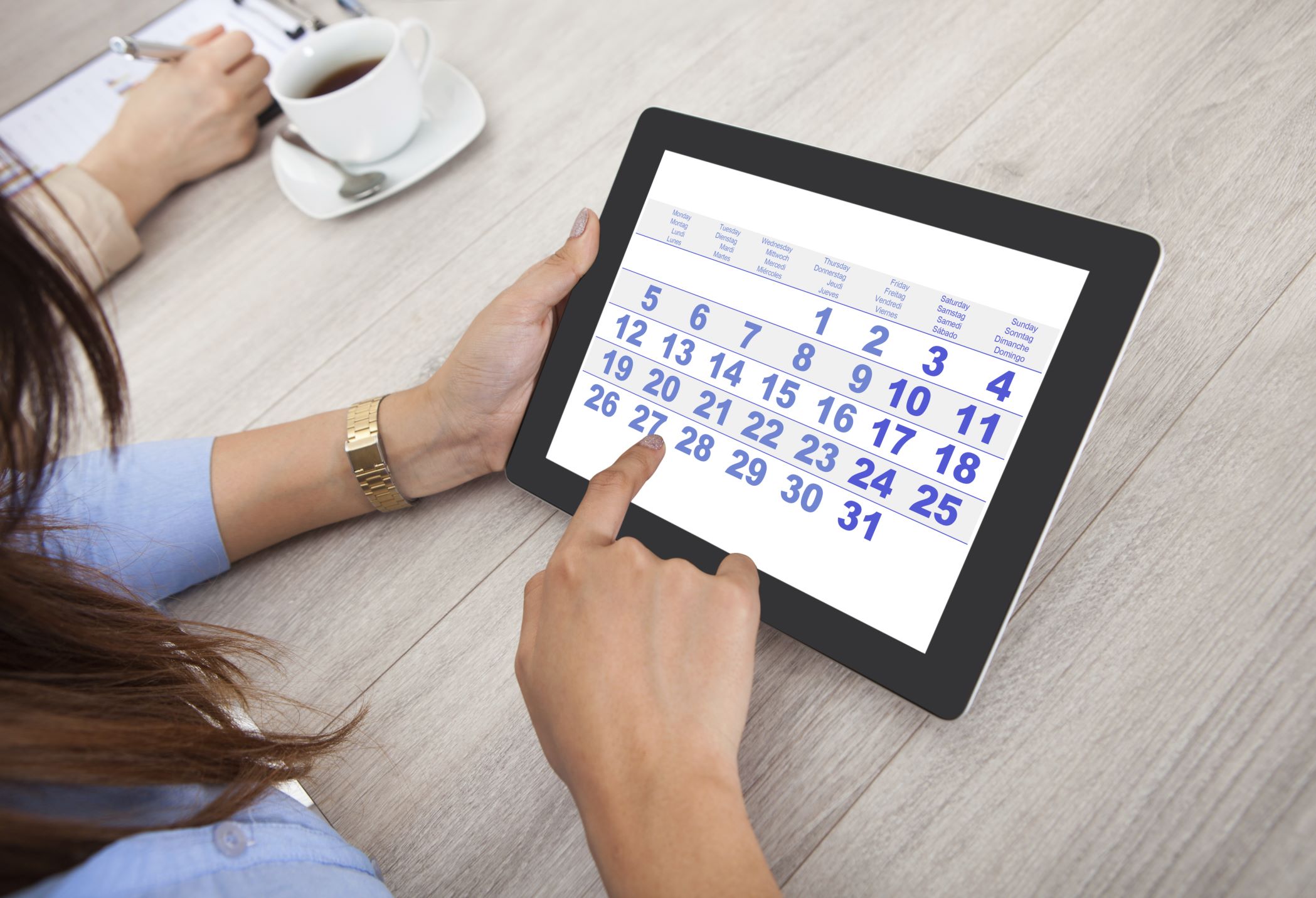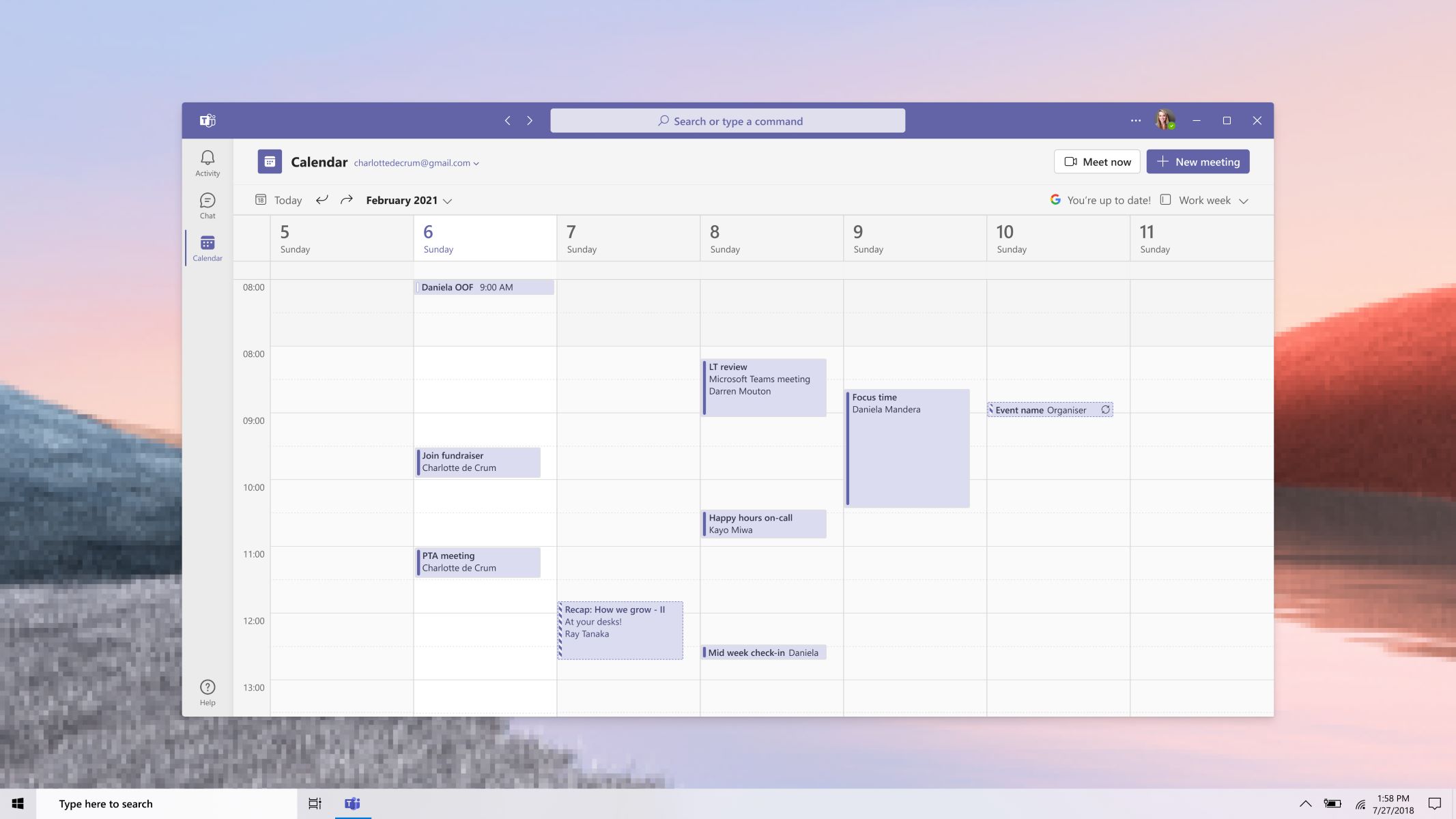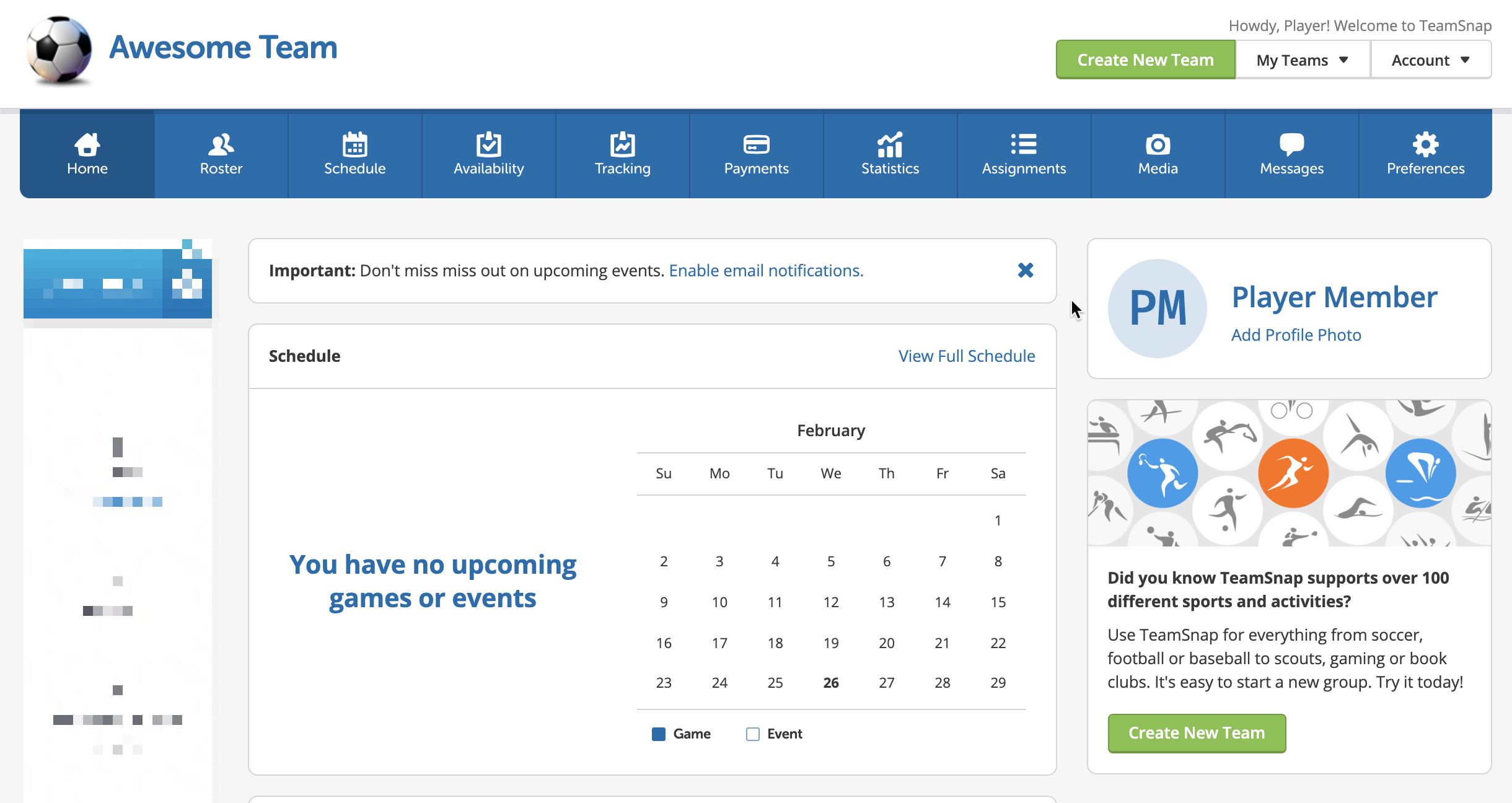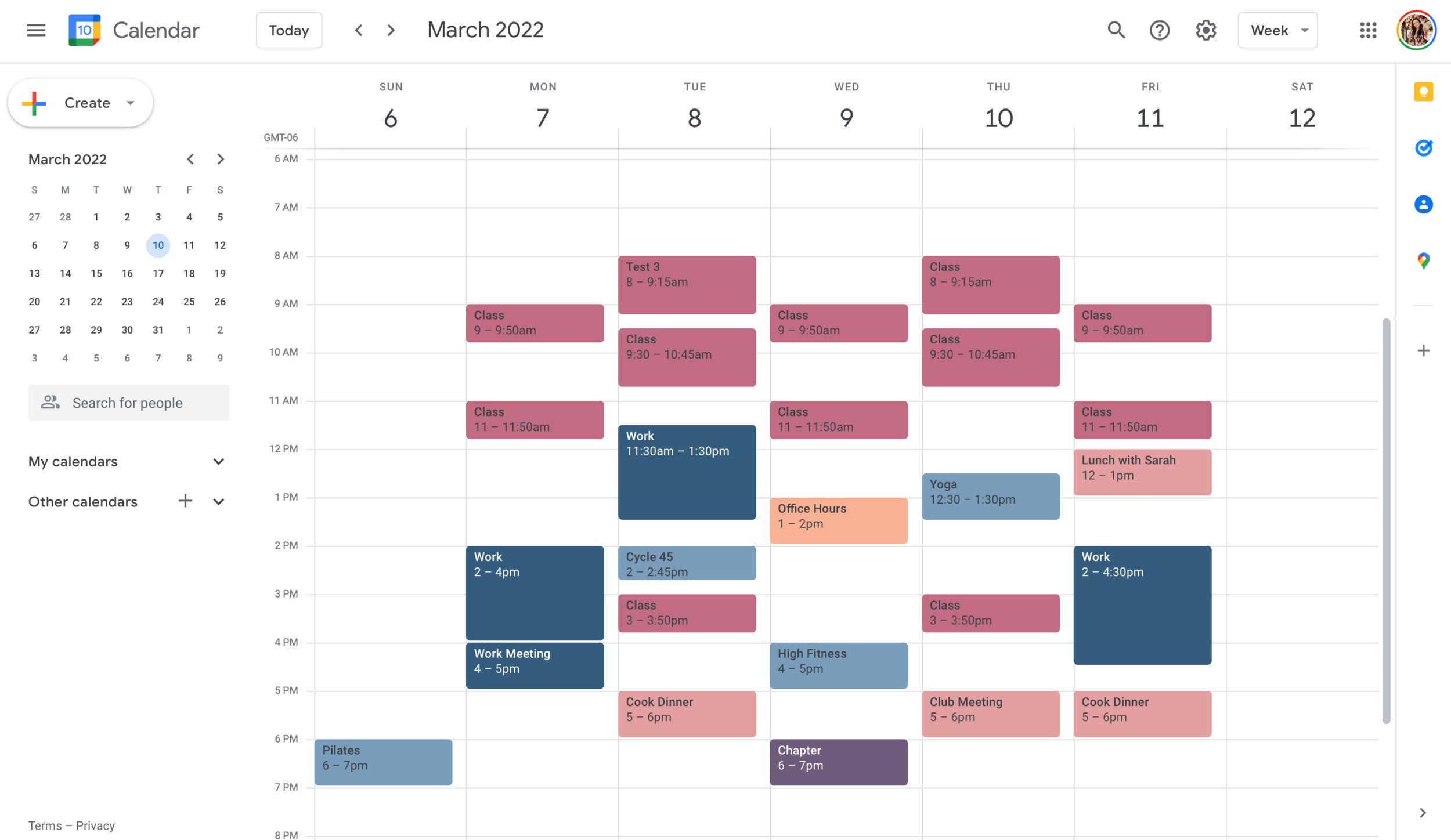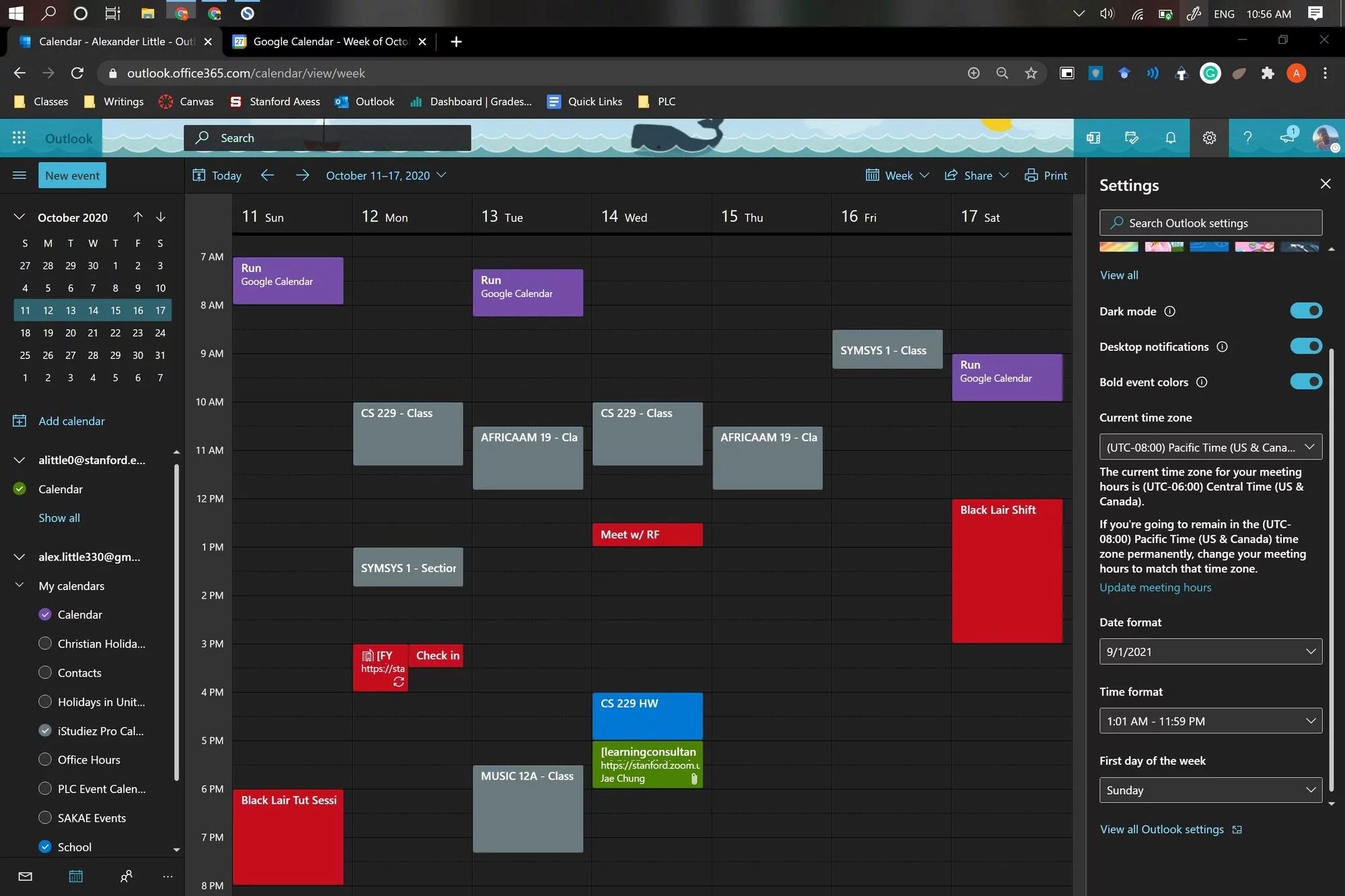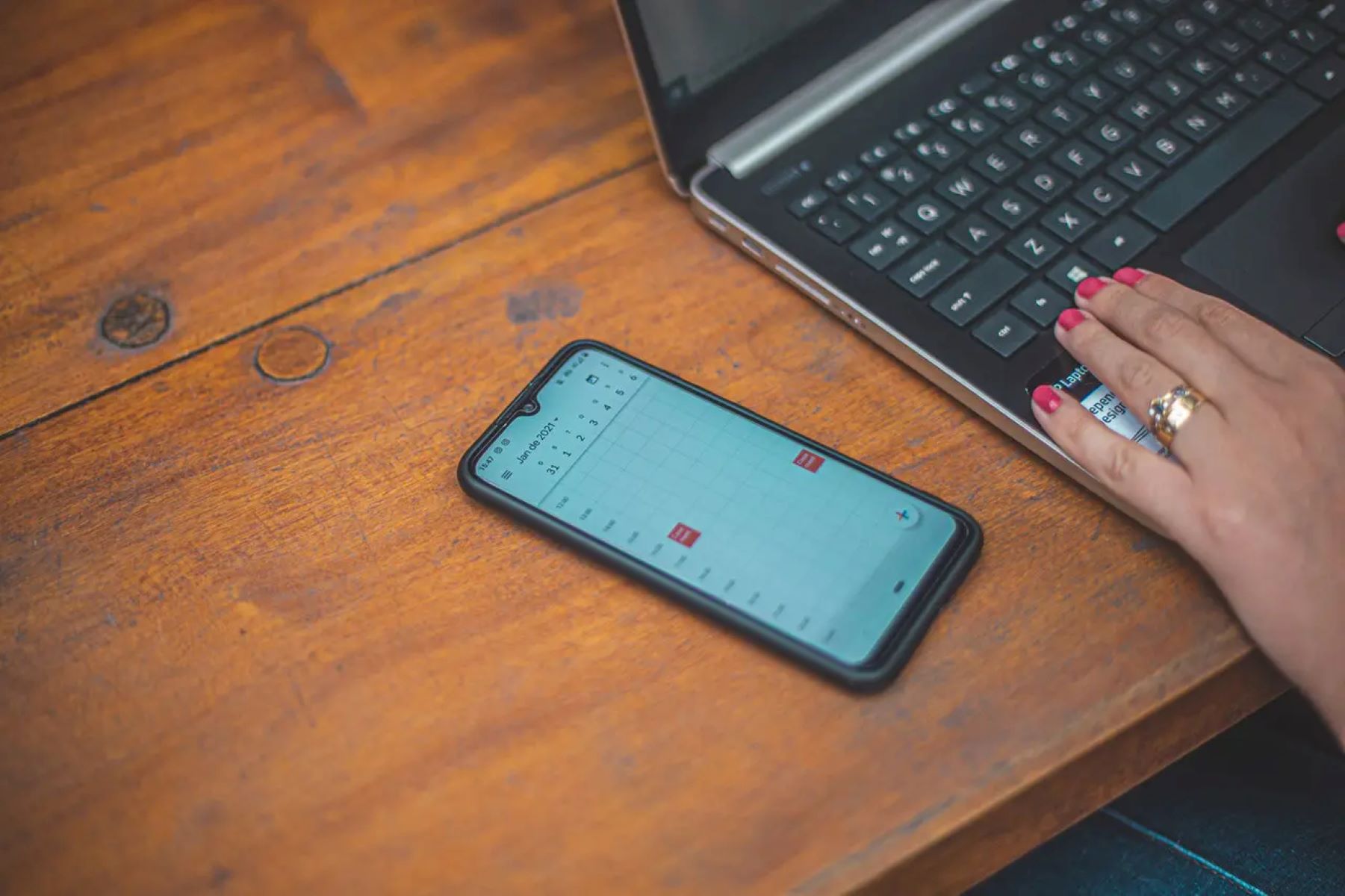Introduction
Google Calendar is a powerful and user-friendly tool that can help you stay organized and manage your schedule effectively. Whether you are a student, a professional, or a busy individual juggling multiple commitments, Google Calendar offers a seamless way to keep track of your appointments, events, and tasks. With its intuitive interface and various features, Google Calendar has become a popular choice for individuals and teams alike.
In this article, we will explore the different aspects of using Google Calendar and provide you with a comprehensive guide on how to make the most out of this versatile tool. From setting up your calendar to syncing it with other devices and customizing the settings to suit your needs, we will cover everything you need to know to become a Google Calendar pro.
With Google Calendar, you can create events, set reminders, invite guests, and even share your calendars with others. Whether you prefer accessing it on your computer or on your mobile device, Google Calendar ensures that you can stay on top of your schedule no matter where you are. Additionally, the seamless integration with other Google services makes it easy to collaborate, share information, and manage your time efficiently.
Throughout this guide, we will provide you with step-by-step instructions, tips, and tricks to help you navigate through the features of Google Calendar effortlessly. Whether you are new to using a digital calendar or just looking to optimize your productivity, this guide will equip you with the knowledge and skills to leverage Google Calendar to its full potential.
So, if you’re ready to take control of your schedule and streamline your life, let’s dive into the world of Google Calendar and discover how this incredible tool can transform the way you manage your time and commitments.
Setting Up Google Calendar
To get started with Google Calendar, you will first need to set up your account. If you already have a Google account, you can simply access Google Calendar by signing in with your existing credentials. If you don’t have a Google account yet, you can easily create one by visiting the Google Account creation page.
Once you have signed in to Google Calendar, you’ll be greeted with a clean and organized interface. On the left-hand side, you will find a menu with various options, including your calendar, tasks, and other calendars you may have added. The main section of the screen displays your calendar view, which can be customized to show different time frames and views such as day, week, month, or even a custom view.
To personalize your Google Calendar further, you can click on the gear icon in the top-right corner to access the settings menu. Here, you can customize your calendar’s appearance, time zone, working hours, and other preferences to align with your needs. It’s worth exploring these settings to ensure an optimized calendar experience tailored to your preferences.
In addition to the basic setup, you can also enable additional features such as event notifications and event color-coding to help keep your calendar organized and ensure that you never miss an important appointment or task. You can also choose to integrate other Google services, such as Gmail, to automatically add events or reminders based on your emails.
Furthermore, Google Calendar offers the option to import or subscribe to other calendars. This feature allows you to overlay multiple calendars, making it easier to manage personal and professional schedules in one place. You can import calendars from other applications or websites, or subscribe to public calendars that are relevant to your interests or industry.
Setting up Google Calendar is a straightforward process that can be done in a matter of minutes. Once your account is set up and your preferences are customized, you’ll be ready to start adding events, inviting guests, and managing your schedule with ease. In the next sections, we’ll delve deeper into the various features and functionalities of Google Calendar to help you make the most out of this valuable tool.
Creating and Deleting Events
One of the core features of Google Calendar is the ability to create and manage events. Whether it’s a business meeting, a social gathering, or a personal appointment, Google Calendar makes it easy to add events to your schedule. Let’s explore how to create events and delete them when they are no longer needed.
To create an event, simply click on the desired time slot on your calendar. A pop-up window will appear, allowing you to enter the event details. Start by adding a title for the event, giving it a descriptive name that captures its purpose. You can also specify the date, time, and duration of the event. If the event is recurring, such as a weekly team meeting, you can select the recurring option and set the desired frequency and end date.
Furthermore, Google Calendar allows you to add additional details to your events. In the event window, you can include a location, add a description, and even attach relevant files or documents. This ensures that all the information related to the event is readily available in one place.
Another useful feature of Google Calendar is the ability to invite guests to your events. Simply enter the email addresses of the attendees in the “Add guests” section, and they will receive an invitation to the event. Guests can choose to accept, decline, or propose a different time for the event, making it easier to coordinate schedules and ensure that everyone is on the same page.
If you need to make any changes to an event or delete it, Google Calendar provides a simple way to do so. To edit an event, simply click on the event on your calendar, and the event details window will appear. From there, you can modify any aspect of the event, such as the title, date, time, or location. Once you have made the necessary changes, click “Save”, and the event will be updated accordingly.
To delete an event, click on the event on your calendar and select the “Delete” option. You will be prompted to confirm the deletion, ensuring that you don’t accidentally remove an important event from your schedule.
Creating and managing events in Google Calendar is a seamless process that allows you to stay organized and keep track of your commitments. By leveraging the features mentioned above, you can ensure that all your events are accurately scheduled, easily accessible, and effectively communicated to the relevant parties. With the ability to edit and delete events when needed, Google Calendar provides the flexibility to adapt to changes in your schedule. Now that you know how to create and delete events, let’s explore how to add more details to your events to enhance their visibility and functionality.
Adding Event Details
When creating events in Google Calendar, it’s essential to provide sufficient details to ensure clarity and effectiveness. In addition to the basic information such as the event title, date, and time, Google Calendar allows you to add additional details that can enhance the visibility and functionality of your events. Let’s explore how to add event details and make the most out of this feature.
To add event details, start by creating a new event or editing an existing one. In the event details window, you’ll find various fields where you can input relevant information. One of the most important details you can add is the event location. This can be a physical address for in-person meetings or a virtual link for online events. Specifying the location ensures that attendees have the necessary information to access the event.
Google Calendar also allows you to include a detailed description for your events. This can be used to provide additional context, agenda, or any other pertinent information. The description field supports rich text formatting, allowing you to add bullet points, hyperlinks, and even images. This makes it easier to provide comprehensive information and resources related to the event.
Additionally, you have the option to attach files to your events. This can be useful for sharing relevant documents, presentations, or any other materials that attendees may need. By attaching files to your event, you can ensure that all the necessary information is easily accessible in one place, saving time and reducing the risk of miscommunication.
In addition to providing event details within the event itself, Google Calendar also offers the option to add guests and track their RSVP status. When inviting guests to your event, they will receive an email with all the pertinent details and the ability to accept, decline, or propose a different time. This tracking feature makes it easier to manage attendee responses and ensure that everyone is aware of the event details.
To maximize the effectiveness of your events, it’s also worth noting that Google Calendar allows you to set reminders and notifications. You can specify when you would like to be reminded before the event, whether it’s minutes, hours, or days in advance. This ensures that you don’t miss any important appointments and helps you stay organized and punctual.
By adding detailed event information, attaching relevant files, and utilizing reminders and notifications, you can ensure that your events in Google Calendar are comprehensive and provide all the necessary context for attendees. This not only enhances the overall organization and flow of your schedule, but it also improves communication and collaboration among event participants. Now that you know how to add event details, let’s explore how to invite guests to your events and manage their responses effectively.
Inviting Guests to Events
One of the key features of Google Calendar is the ability to invite guests to your events. Whether you’re organizing a team meeting, a social gathering, or a webinar, inviting the relevant individuals ensures that everyone is aware of the event and can participate accordingly. Let’s explore how to invite guests to your events and manage their responses effectively.
To invite guests to an event in Google Calendar, start by creating a new event or editing an existing one. In the event details window, you’ll find a field labeled “Add guests.” Here, you can enter the email addresses of the individuals you would like to invite. As you type, Google Calendar will suggest contacts from your saved contacts list, making it easy to select the desired guests.
Once you have added the guests, they will receive an email invitation with all the event details. The email will provide them with options to accept, decline, or propose a different time if the original time doesn’t work for them. Invited guests can also choose to add the event to their own calendar, ensuring that they don’t forget it.
In addition to email invitations, Google Calendar also offers the option to share event links. This is particularly useful for events with a large number of attendees or events where you want to make the registration process more streamlined. By sharing the event link, individuals can access the event details and RSVP directly without needing an email invitation.
To effectively manage guest responses, Google Calendar provides clear indications of who has accepted, declined, or proposed a different time for the event. This allows you to keep track of attendee participation and make any necessary adjustments accordingly. You can view the guest responses within the event details or on your calendar view, making it easy to monitor the status of your invitees.
Furthermore, Google Calendar provides the option to send event updates to all attendees. If there are any changes to the event details, such as the date, time, or location, you can update the event and choose to notify all guests of the changes. This ensures that everyone is kept informed and eliminates any confusion or miscommunication.
By inviting guests to your events in Google Calendar, you can effectively communicate and coordinate with the relevant individuals, ensuring that everyone is aware of the event and can participate accordingly. The ability to track guest responses and send event updates facilitates seamless collaboration and reduces the risk of scheduling conflicts. Now that you know how to invite guests, let’s explore the options for setting reminders and notifications to stay on top of your events in Google Calendar.
Setting Reminders and Notifications
Google Calendar offers the flexibility of setting reminders and notifications for your events to ensure that you never miss an important appointment or task. By utilizing this feature, you can stay organized, punctual, and on top of your schedule. Let’s explore how to set reminders and notifications in Google Calendar.
To set a reminder for an event, start by creating a new event or editing an existing one. In the event details window, you’ll find an option labeled “Reminder.” Click on the drop-down menu and choose the desired timing for your reminder. You can set reminders to alert you minutes, hours, or days before the event. If you prefer, you can also choose the “Custom” option and specify a particular time for the reminder.
In addition to reminders, Google Calendar allows you to receive notifications for your events. Notifications are similar to reminders, but they provide an additional layer of visibility by sending you a pop-up alert or an email at the specified time. To set a notification for an event, click on the “Notification” option in the event details window. Similar to reminders, you can select the desired timing for the notification or customize it to suit your preferences.
Furthermore, Google Calendar offers the option to set default reminders and notifications for all events. This means that every new event you create will automatically have the default reminder and notification settings applied. You can access the default settings by clicking on the gear icon in the top-right corner, selecting “Settings,” and navigating to the “Event settings” tab. From there, you can set the default reminder and notification timing, ensuring that you never forget an event.
It’s worth noting that Google Calendar also allows you to choose the preferred method of receiving notifications, such as email, pop-up, or both. You can customize these settings in the “Notifications” section of the settings menu, ensuring that you receive event alerts in the format that works best for you.
By setting reminders and notifications in Google Calendar, you can effectively manage your schedule and ensure that you are always aware of upcoming events. By receiving timely reminders and notifications, you can avoid the stress of last-minute preparations and stay on top of your commitments. Now that you know how to set reminders and notifications, let’s explore how to share Google Calendars with others for seamless collaboration and coordination.
Sharing Calendars with Others
Google Calendar offers the convenient option to share your calendars with others, making it easier to collaborate, coordinate, and stay informed about each other’s schedules. Whether you want to share your calendar with colleagues, friends, or family members, Google Calendar provides a seamless way to ensure everyone is on the same page. Let’s explore how to share calendars with others in Google Calendar.
To share your calendar, start by accessing the settings for the specific calendar you want to share. Click on the gear icon in the top-right corner, select “Settings,” and navigate to the “Calendars” tab. Locate the calendar you want to share and click on the “Share this calendar” option.
In the sharing settings, you have the option to provide different levels of access to individuals or groups. You can choose to make the calendar public, which allows anyone with the link to view your schedule. Alternatively, you can specify individual email addresses to share the calendar privately with selected individuals.
Depending on the access level you choose, individuals can view your calendar, make changes, or even manage sharing settings themselves. It’s important to consider your privacy preferences and the level of collaboration required when setting sharing permissions for your calendar.
For more advanced sharing options, Google Calendar allows you to grant specific permissions to individuals or groups. You can determine whether the shared users can only view the events, make changes, or invite others to events. This granular control ensures that you maintain control over your calendar while still allowing collaboration and coordination.
In addition to sharing your calendar, Google Calendar also allows you to subscribe to other calendars. This can be useful for keeping track of public events, holidays, or specific industry-related calendars. By subscribing to external calendars, events from those calendars will be overlaid onto your own, creating a comprehensive view of your schedule.
Furthermore, if you’re part of a team or organization, Google Calendar offers the option to create and manage shared calendars. This allows team members to collaborate and view each other’s schedules, making it easier to schedule meetings, allocate resources, and stay organized as a group.
By sharing calendars with others in Google Calendar, you can enhance collaboration, coordination, and communication. Whether you’re working on a team project, planning family events, or coordinating social activities, shared calendars ensure that everyone involved is aware of the schedule and can contribute effectively. Now that you know how to share calendars, let’s explore how to sync Google Calendar with other apps or devices to keep your schedule up to date across various platforms.
Syncing Google Calendar with Other Apps or Devices
Syncing Google Calendar with other apps or devices allows you to access and manage your schedule seamlessly across multiple platforms. Whether you prefer using a specific calendar app on your mobile device or integrating Google Calendar with your favorite productivity tools, syncing ensures that your events and appointments stay up to date. Let’s explore how to sync Google Calendar with other apps or devices.
One of the simplest ways to access your Google Calendar on your mobile device is by using the official Google Calendar app. Available for both Android and iOS devices, the Google Calendar app allows you to view, create, and manage events directly from your smartphone or tablet. Simply download the app from the respective app store, sign in with your Google account, and your calendars will be automatically synced.
If you prefer using a different calendar app on your mobile device, you can still sync Google Calendar with that app. Most popular calendar apps, such as Apple Calendar, Microsoft Outlook, and Samsung Calendar, offer the option to add accounts from different providers, including Google. By adding your Google account to the app’s settings, your Google Calendar events will be synced and accessible within the app.
In addition to syncing with mobile apps, Google Calendar can be integrated with various productivity tools and platforms. For example, if you use a project management app like Trello or Asana, you can connect it to your Google Calendar to automatically create tasks or events based on your project timelines. Similarly, you can sync Google Calendar with tools like Slack or Microsoft Teams to receive event reminders and notifications directly in your team communication channels.
Furthermore, Google Calendar offers a variety of integration options for popular business and productivity tools through its “Calendar Interoperability” feature. This allows you to sync and manage your Google Calendar events with applications such as Microsoft Office 365, Salesforce, and other CRM systems. By integrating your calendars across platforms and tools, you can ensure that all your appointments and commitments are centralized and coordinated.
It’s worth noting that when syncing Google Calendar with other apps or devices, updates made in one app will be reflected in all synced platforms. This means that when you add, edit, or delete events on your mobile device, in a third-party calendar app, or in Google Calendar itself, the changes will be synchronized across all platforms in real-time.
By syncing Google Calendar with other apps or devices, you can stay organized and keep track of your schedule effortlessly, no matter where you are or which platform you prefer. From accessing your calendar on your mobile device to integrating it with your favorite productivity tools, syncing ensures that your events and appointments are always up to date. Now that you know how to sync Google Calendar, let’s explore how to use Google Calendar on mobile devices for convenient on-the-go scheduling.
Using Google Calendar on Mobile Devices
Google Calendar offers a convenient and user-friendly mobile app that allows you to access and manage your schedule on the go. Whether you’re using an Android or iOS device, the Google Calendar app provides a seamless experience for keeping track of your events, setting reminders, and collaborating with others. Let’s explore how to use Google Calendar on mobile devices effectively.
To get started, download the Google Calendar app from the Google Play Store (for Android devices) or the App Store (for iOS devices). Once installed, sign in with your Google account to sync your calendars across devices.
The app’s intuitive interface displays your calendar events in a clean and organized manner. You can easily switch between day, week, month, or agenda views to find the schedule display that suits your needs. To view the details of a specific event, tap on it to access the event details page.
Creating events on the mobile app is simple. Tap on the “+” button to start creating a new event. You can enter the event title, date, time, location, and other details. You can also add guests to the event by typing in their email addresses. Once you’ve added all the necessary information, tap “Save,” and the event will be added to your calendar.
The Google Calendar app allows you to set reminders for your events. When creating or editing an event, you can set a reminder to alert you at a specific time before the event starts. The app will send a notification to your device to ensure you don’t miss any important appointments or tasks.
Collaboration is made seamless with the Google Calendar app. You can invite guests to events, and they will receive email invitations with the event details. Guests can RSVP and even propose different times if the original time doesn’t work for them. This feature makes it easy to coordinate schedules and ensure that everyone is on the same page.
The mobile app also offers a “Goals” feature where you can set and track personal or professional goals. You can specify the frequency, duration, and preferred times for your goals, and Google Calendar will automatically find time slots in your schedule to work towards achieving those goals.
In addition to creating and managing events, the Google Calendar app allows you to customize your calendar settings. You can adjust notification preferences, set working hours, change calendar colors, and enable daily agendas, among other options.
Google Calendar seamlessly integrates with other apps and services on your mobile device. You can pair it with your favorite productivity apps, such as task managers or note-taking apps, to ensure a cohesive workflow and centralize all your scheduling and planning activities.
Using Google Calendar on your mobile device provides you with the flexibility to stay organized and manage your schedule while on the move. With its user-friendly interface, collaboration features, and integration options, the Google Calendar app is a powerful tool for efficient time management. Now that you know how to use Google Calendar on mobile devices, let’s explore how to customize your calendar settings to fit your specific needs.
Customizing Google Calendar Settings
Google Calendar offers a wide range of customization options that allow you to personalize your calendar and tailor it to your specific needs. From changing the appearance of your calendar to adjusting time zones and notification settings, customizing Google Calendar allows you to optimize your scheduling experience. Let’s explore how to customize your calendar settings effectively.
To access the Google Calendar settings, click on the gear icon in the top-right corner of the calendar interface and select “Settings” from the drop-down menu.
Under the “General” tab, you can customize the time zone and set your preferred working hours. By specifying your time zone, Google Calendar ensures that all event times are accurately displayed in your local time. Setting your working hours helps prevent scheduling conflicts and ensures that your availability is accurately reflected on your calendar.
The “Event settings” tab allows you to customize default event durations, enable or disable event color coding, and specify the visibility of event details. Adjusting default event durations can save time when creating events by automatically setting the desired duration. Event color coding provides visual cues to help differentiate between different types of events or calendars. You can also choose to show or hide event details in the calendar display to optimize the amount of information you see at a glance.
Under the “Notifications” tab, you can customize the notifications you receive for upcoming events. You can choose to receive email notifications, pop-up notifications on your device, or both. Additionally, you can set the timing of the notifications, such as receiving alerts minutes, hours, or days before an event. Customizing your notifications ensures that you stay informed about upcoming events and never miss an important appointment.
The “View options” tab allows you to further customize the appearance of your calendar. You can choose between different date and time formats, select your preferred first day of the week, and adjust the default view and time range when you first open Google Calendar. These options make it easier to align your calendar display with your personal preferences and work habits.
In addition to these settings, Google Calendar offers advanced customization options for more specific needs. For example, you can enable or disable the “Working Hours” feature to highlight your available working times in your calendar view. You can also integrate Google Calendar with other apps and services by accessing the “Integrations” tab in the settings menu.
By customizing your Google Calendar settings, you can create a personalized scheduling experience that aligns with your specific preferences and requirements. Whether it’s adjusting time zones, customizing event durations, or choosing the visibility of event details, these settings allow you to tailor Google Calendar to suit your needs. Now that you know how to customize your calendar settings, you can optimize your scheduling experience and make the most out of Google Calendar.
Conclusion
Google Calendar is a versatile and powerful tool that helps you stay organized, manage your schedule, and collaborate effectively. By following the steps laid out in this guide, you can make the most out of Google Calendar and harness its features to optimize your time management skills.
We began by exploring how to set up Google Calendar, customize it to suit your preferences, and navigate its intuitive interface. We then delved into creating events, adding event details, inviting guests, and managing responses. Additionally, we covered how to set reminders and notifications, share calendars with others, sync Google Calendar with other apps or devices, and use the Google Calendar mobile app.
By leveraging the customization options, collaboration features, and integration capabilities of Google Calendar, you can streamline your scheduling process, enhance productivity, and ensure effective communication with your team, colleagues, friends, and family members.
Remember to explore the various settings available in Google Calendar to optimize your experience. Customize your reminder timing, choose your preferred notification method, and adjust the appearance to match your personal preferences. By customizing Google Calendar to fit your specific needs, you can create a scheduling system that works for you.
In conclusion, Google Calendar is an invaluable tool that can revolutionize your approach to time management. By effectively utilizing its features and options, you can take control of your schedule, stay organized, and increase your productivity. Whether you’re a student, a professional, or an individual with a busy lifestyle, Google Calendar provides the flexibility and versatility needed to keep up with your commitments. Start utilizing Google Calendar today and embark on a journey towards enhanced efficiency and success in managing your time.







